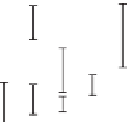Agriculture Reference
In-Depth Information
(A) Untilled
1.5
Control
Fertilized
1.0
0.5
0.0
(B) Annually Tilled
1.5
1.0
0.5
0.0
1
23456 789101112131415161718192021
Years after Abandonment
Figure 7.5
. Interannual variability in aboveground biomass production in the Disturbance
by N-Fertilization Experiment in the MCSE Early Successional system following abandon-
ment (Year 1=1989) from control (unfertilized) and fertilized (nitrogen added) in A) untilled,
successional and B) annually tilled treatments. Samples were harvested at peak biomass,
typically late-July (untilled) and mid-August (tilled). Values are means ± SE, n = 6.
the annually tilled treatment, suggesting that different external drivers controlled
productivity in these communities. This difference may be due to species-specific
differences in recruitment of annual weeds in response to precipitation, as exempli-
fied by the dominant grass species
S. faberi,
which as discussed earlier, accounts for
much of the weed productivity in these systems (Robinson 2011).
Nitrogen fertilization reduced species richness approximately 20% in both the
untilled and annually tilled treatments (Fig. 7.6). While this response was rela-
tively rapid in the annually tilled community (Fig 7.6B), it took 14 years before
fertilization had a detectable effect on species richness in the untilled community
(Fig. 7.6A). A recent meta-analysis of fertilization experiments in grasslands sug-
gests that community composition, specifically the presence of “tall runners” (i.e.,
clonal populations of plants of tall stature interconnected underground by hori-
zontal roots), can influence the magnitude of fertilization-driven changes in spe-
cies diversity (Gough et al. 2012). Tall-runner species appeared in MCSE fields
a few years after abandonment from agriculture, but as a functional group, they






























































































